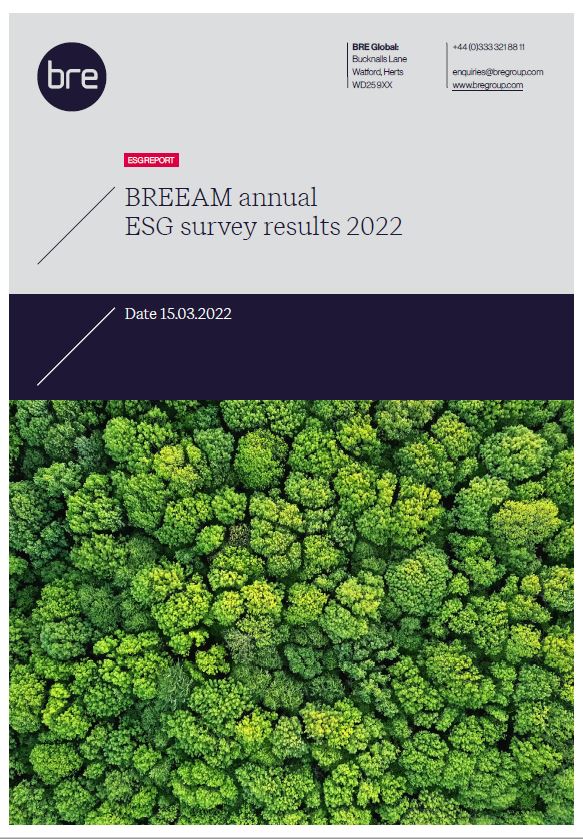BREEAM’s transparency, robustness and rigour validates sustainability claims, supports data-driven solutions and provides assurance for disclosures and reporting requirements.
Our vision is to provide built environment stakeholders with the information they need to develop and operate better performing assets. By utilising robust science, third-party assurance and flexible frameworks across the entire built environment lifecycle, BREEAM will support asset investors, owners and operators by unlocking valuable insights to inform decision making and achieve their sustainability and ESG goals.
Making disclosures and reporting easier with BREEAM:
- Supporting ESG reporting and solutions.
- Informing and knowledge sharing around EU and UK taxonomies.
- Mapping the BREEAM schemes with the UN Sustainable Development Goals (SDGs).
- Providing a mechanism to obtain green finance and measure success.
- Providing third-party verification and assurance of sustainability claims.
To find out more, please call us on+443333218811 or fill out our form, and one of our experts will be in touch.
EU & UK Taxonomies
The EU Taxonomy is a clear and detailed classification system used to define environmentally sustainable economic activities. It provides companies, investors, and policymakers with a common language and a clear definition of what is ‘sustainable’. It creates security for investors, protects against greenwashing, helps companies to become more climate-friendly, mitigates market fragmentation, and helps to shift investments where they are most needed.
The UK Government also announced in the report Greening Finance: A Roadmap to Sustainable Investing that the forthcoming UK Green Taxonomy will be based on the EU Taxonomy approach.
The UK Taxonomy will build on existing international taxonomies, including the EU Taxonomy, and will focus on net-zero in the UK context.

ESG reporting

ESG (or environmental, social and governance) objectives are the key metrics that companies report against to showcase their achievements when tackling environmental issues, a balance of initiatives around people-centric topics, or the way in which they manage their organisational processes.
ESG is becoming a very important topic for global investors, financiers, asset owners, asset managers and corporates as they seek to manage the impacts that their businesses have on the planet at large, and the negative reputational risks of this that bad practice can have. Good ESG practice shows that an organisation is conducting its operation in full awareness of the impact that it is having and seeks to manage those impacts to minimise or nullify them. ESG is undergoing a huge growth at this time, with global investors seeing an ESG approach as the best route to create business resilience and longer term, planet-friendly, growth.
Explore how BREEAM aligns with GRESB to assess & benchmark the ESG performance of assets.
Green finance
Green finance is where a customer has borrowed money from a lender, where, as part of the loan conditions, there is a requirement for the borrower to improve the energy & carbon performance of the asset being lent against throughout the loan duration. An example might be a bank lending funds to a hotel owner to undertake a refurbishment of a hotel building. The lender would ask for an improved energy performance of the building at the time when the client exits from the loan. The improvement is part of the terms of the loan and often requires evidence of ‘before’ and ‘after’ performance. The green lending market is seeing considerable growth, with the Climate Bonds Initiative estimating the market for green bonds to exceed $1t by the end of 2023. Green finance is here to stay and will only be accelerating as organizations set an achieve their net zero goals.

Sustainable Development Goals

The UN Sustainable development goals (SDGs) are an urgent call for action, providing a blueprint for global peace and prosperity.
These 17 goals highlight how all aspects of sustainability are connected, and thus, they echo BREEAM’s holistic approach to environmental assessment.
Explore how the BREEAM suite of schemes align with the UN Sustainable Development Goals further
EU & UK Taxonomy in BREEAM
As the world’s leading science-based suite of validation and certification systems for a sustainable built environment, BREEAM is ideally placed to demonstrate alignment with both EU Taxonomy and UK Green Taxonomy. The ethos of BREEAM and EU taxonomy complement one another. Read more here about how BREEAM will evaluate the evolving requirements of the EU Taxonomy against the suite of BREEAM schemes.
In addition, BRE is advising on the development of a UK Taxonomy by feeding into the Green Technical Advisory Group (GTAG) sub-group for the Built Environment as a subject expert to advise on the Technical Screening Criteria (TSC) for the following specific economic activities:
- New construction
- Building renovation
- Acquisition and ownership of properties
The group will have the ability to work collaboratively on how to optimise the buildings’ relevant criteria for the referred economic activities through design, existing data and methodologies, and pros and cons from international regimes.
BRE is committed to continue offering robust and scientific advice on usable and practicable TSC requirements and taxonomy criteria. The GTAG Built Environment group will help accelerate green finance as well as support the UK’s transition to a net-zero economy.
ESG reporting in BREEAM
As a family of technical holistic sustainability standards, underpinned by robust science and addressing the entire built environment lifecycle, BREEAM supports clients in achieving their ESG objectives by giving a framework against which performance can be measured and verified with third-party certification.
Our certification operates at the same level of rigour, for example, as an auditor who is assessing and validating a set of company accounts. When the BREEAM credits have been awarded, the client can be confident that the target has been met. Here are a few examples of how BREEAM can support ESG outcomes:
- Being sure that a certain energy performance target (an associated carbon emissions target) has been met for reporting purposes.
- Understanding the performance of your buildings in terms of water and waste to support company ESG statements.
- Creating and evidencing positive biodiversity gain in your development projects.
- Facilitating a healthier environment for employees or tenants to enjoy and enhancing wellness.
- Supporting better communication in your project teams, enhancing inclusivity and mental wellbeing for employees.
Green finance in BREEAM
When lenders are making decisions in support of green initiatives, they will often require a measurement of the starting position pre-loan and then the exit post-loan showing an improvement in the environmental credentials of a building. This is where the BREEAM family of technical standards can play a big part, acting as the reliable mechanism for measurement and verification.
This is where the rigorous BREEAM frameworks come into their own. With a robust third-party assessment verifying the start and endpoint, lenders can be confident that the energy, carbon & emissions targets have been met as a consequence of the loan. For example, funds lent for the refurbishment of a cinema building have delivered the asset improvement programmed but also the environmental uplift too. This is very important to the lender to understand, as they can claim the emissions improvement within their Scoped emissions too. All underpinned by the power of BREEAM.
As a general rule, if it’s easy, it probably means it’s greenwashing. But at the other end of the spectrum, too much time-consuming data collection to demonstrate sustainability is not the solution either. This is where a holistic scheme like BREEAM proves its worth. It covers a broad range of environmental, social and governance issues at individual building level and, as it is monitored by a third party, it helps to make assessments credible and to verify sustainability claims…
Derk Welling, Senior Responsible Investment and Governance Specialist, APG Asset Management in The Sunday Times.
Train with BREEAM

Train with us to provide built environment sustainability solutions and learn how to support clients with disclosures and reporting.
Our BREEAM training courses teach you how to use the world’s leading green building tool to achieve sustainability success. Millions of assets all over the world are registered with BREEAM and starting their journey to sustainability success.
BREEAM ESG reports
Learn more about ESG & the role BREEAM can play in our ESG reports.
Fill in the form below to download:
- The BREEAM annual ESG survey report
- ESG frameworks report

BREEAM Case studies
Browse the latest case studies from BREEAM

Aligning ESG goals: LXP’s collaborative approach to Green Building Standards

Using BREEAM across an asset’s lifecycle: Hermes Business Campus

World’s largest real estate certification powered by BREEAM In-Use for Dutch investors Vesteda

Natural cosmetics company APIVITA awarded with BREEAM In-Use ‘Excellent’ rating for Athens headquarters ‘The Hive’

BNP Paribas Real Estate and Generali Real Estate achieve target of BREEAM In-Use V6 Excellent rating

China Basin – Achieving BREEAM Very Good rating on a waterfront Tech & Life Sciences Campus in San Francisco
Get in touch
